#crm software examples
Explore tagged Tumblr posts
Text

The customized lens cleaning spray by DNB Multiapps LLP is a premium alcohol-based formula designed to keep your eyewear lenses spotless and clear. You can personalize the bottle with your shop’s logo, creating a unique marketing tool that also adds value for your customers. It's the perfect blend of functionality and brand promotion! 🕶️✨
#software for retail store#pos software#retail shop software#software for shop#crm software examples
0 notes
Text
The #1 Best Business CRM Solutions For Big Companies
Looking for the top business CRM solutions? Here are the best CRM software examples for large enterprises! Business landscape, the significance of Customer Relationship Management (CRM) software cannot be overstated, as it has become an integral tool for efficiently overseeing customer interactions and information. This holds particularly true for sizable enterprises, which heavily rely on…

View On WordPress
#CRM business solution#CRM market share#CRM software examples#CRM software market#Customer Relationship Management
0 notes
Text
Amika Softwares provides various IT-related blog topics that deeply share information about Custom Software, SEO Services, Website Development, CRM & ERP solutions for business, etc.
#blogs#blogs on IT softwares#Create blogs#Learn who blog content works#How to create blogs#Blog examples#Blog on Custom Software solution#Blogs on Website development#blogs on CRM#Blog on SEo#Blog on ERP
1 note
·
View note
Text

How to Choose the Best CRM Software for Your Business
Choosing the right CRM software for your business is a big decision — and the right one can make a world of difference. Whether you’re running a small startup or managing a growing company, having an effective CRM (Customer Relationship Management) system helps you keep track of customers, boost sales, and improve overall productivity. Let’s walk through how you can choose the best CRM for your business without getting overwhelmed.
Why Your Business Needs a CRM
A CRM isn’t just a tool — it’s your business’s central hub for managing relationships. If you’re still relying on spreadsheets or scattered notes, you’re probably losing time (and leads). A good CRM helps you:
Keep customer data organized in one place
Track leads, sales, and follow-ups
Automate routine tasks
Get insights into sales performance
Improve customer service
The goal is simple: work smarter, not harder. And with an affordable CRM that fits your needs, you’ll see faster growth and smoother processes.
Define Your Business Goals
Before diving into features, figure out what you actually need. Ask yourself:
Are you trying to increase sales or improve customer service?
Do you need better lead tracking or marketing automation?
How big is your team, and how tech-savvy are they?
What’s your budget?
Knowing your goals upfront keeps you from wasting time on CRMs that might be packed with unnecessary features — or worse, missing key ones.
Must-Have Features to Look For
When comparing CRM options, focus on features that truly matter for your business. Here are some essentials:
Contact Management – Store customer details, interactions, and notes all in one place.
Lead Tracking – Follow leads through the sales funnel and never miss a follow-up.
Sales Pipeline Management – Visualize where your deals stand and what needs attention.
Automation – Save time by automating emails, reminders, and data entry.
Customization – Adjust fields, workflows, and dashboards to match your process.
Third-Party Integrations – Ensure your CRM connects with other software you rely on, like email marketing tools or accounting systems.
Reports & Analytics – Gain insights into sales, performance, and customer behavior.
User-Friendly Interface – If your team finds it clunky or confusing, they won’t use it.
Budget Matters — But Value Matters More
A CRM doesn’t have to cost a fortune. Plenty of affordable CRM options offer robust features without the hefty price tag. The key is balancing cost with value. Don’t just chase the cheapest option — pick a CRM that supports your business growth.
Take LeadHeed, for example. It’s an affordable CRM designed to give businesses the tools they need — like lead management, sales tracking, and automation — without stretching your budget. It’s a smart pick if you want to grow efficiently without overpaying for features you won’t use.
Test Before You Commit
Most CRMs offer a free trial — and you should absolutely use it. A CRM might look great on paper, but it’s a different story when you’re actually using it. During your trial period, focus on:
How easy it is to set up and start using
Whether it integrates with your existing tools
How fast you can access and update customer information
If your team finds it helpful (or frustrating)
A trial gives you a real feel for whether the CRM is a good fit — before you commit to a paid plan.
Think About Long-Term Growth
Your business might be small now, but what about next year? Choose a CRM that grows with you. Look for flexible pricing plans, scalable features, and the ability to add more users or advanced functions down the line.
It’s better to pick a CRM that can expand with your business than to go through the hassle of switching systems later.
Check Customer Support
Even the best software can hit a snag — and when that happens, you’ll want reliable support. Look for a CRM that offers responsive customer service, whether that’s live chat, email, or phone. A system is only as good as the help you get when you need it.
Read Reviews and Compare
Don’t just rely on the CRM’s website. Read reviews from other businesses — especially ones similar to yours. Sites like G2, Capterra, and Trustpilot offer honest insights into what works (and what doesn’t). Comparing multiple CRMs ensures you make a well-rounded decision.
The Bottom Line
Choosing the best CRM software for your business doesn’t have to be complicated. By understanding your goals, focusing on essential features, and keeping scalability and budget in mind, you’ll find a CRM that fits like a glove.
If you’re looking for an affordable CRM Software that checks all the right boxes — without cutting corners — LeadHeed is worth exploring. It’s built to help businesses like yours manage leads, automate tasks, and gain valuable insights while staying within budget.
The right CRM can transform how you run your business. Take the time to find the one that supports your growth, keeps your team organized, and helps you deliver an even better experience to your customers.
3 notes
·
View notes
Text
How Enterprises Use Voice APIs for Call Routing and IVR Automation
Enterprises today handle thousands of customer calls every day. To manage these efficiently, many are turning to voice APIs. These tools help businesses automate call routing and interactive voice response (IVR) systems.

What Are Voice APIs?
Voice APIs are software interfaces that allow developers to build voice-calling features into apps or systems. These APIs can trigger actions like placing calls, receiving them, or converting speech to text. For enterprises, voice APIs make it easy to integrate intelligent call handling into their workflow.
Smarter Call Routing
Call routing directs incoming calls to the right agent or department. With voice APIs, this process becomes dynamic and rules based.
For example, a customer calling from a VIP number can be routed directly to a premium support team. APIs allow routing rules based on caller ID, time of day, location, or even previous interactions. This reduces wait times and improves customer satisfaction.
Automated IVR Systems
Interactive Voice Response (IVR) lets callers interact with a menu system using voice or keypad inputs. Traditional IVR systems are rigid and often frustrating.
Voice APIs enable smarter, more personalized IVR flows. Enterprises can design menus that adapt in real time. For instance, returning callers may hear different options based on their past issues. With speech recognition, users can speak naturally instead of pressing buttons.
Scalability and Flexibility
One major benefit of using voice API is scalability. Enterprises don’t need physical infrastructure to manage call volume. The cloud-based nature of voice APIs means businesses can handle spikes in calls without losing quality.
Also, changes to call flows can be made quickly. New routing rules or IVR scripts can be deployed without touching hardware. This agility is crucial in fast-moving industries.
Enhanced Analytics and Integration
Voice APIs also provide detailed data. Enterprises can track call duration, drop rates, wait times, and common IVR paths. This data helps optimize performance and identify pain points.
Moreover, APIs easily integrate with CRMs, ticketing systems, and analytics tools. This ensures a seamless connection between calls and other business processes.
Final Thoughts
Voice APIs are transforming how enterprises manage voice communications. From intelligent call routing to adaptive IVR systems, the benefits are clear. Enterprises that adopt these tools gain speed, efficiency, and better customer experience, and that too without a lot of effort.
4 notes
·
View notes
Text
How Networking Helps You Gain Insights and Stay Ahead

Networking is a powerful tool for personal and professional growth, offering valuable insights, opportunities, and knowledge. It’s about building relationships that help individuals and organizations stay ahead in a competitive world. In today’s fast-paced, globalized environment, networking is crucial, especially in industries like Business Process Outsourcing (BPO). Leveraging these connections can give you a significant edge, whether you're an entrepreneur, business leader, or working in BPO.
Understanding its Value
At its core, networking is about creating a system of relationships to navigate your professional journey. Whether it's gaining critical information, understanding market trends, or learning from others' experiences, networking helps you stay informed and ahead of the competition. For those seeking business networking services in Prayagraj, leveraging these connections is key to staying competitive and successful.
Networking is not just about meeting people, but interacting with a diverse pool of knowledge and experience.
Relationships go beyond business cards, involving discussions, meetings, and collaborations.
Networking provides access to fresh perspectives, joint venture opportunities, and insights into emerging trends.
Tapping into others' expertise helps you understand market dynamics, technological advancements, and customer expectations.
This knowledge enables you to make informed decisions and stay ahead of competitors who may not have the same access to information.
Networking in the BPO Industry
The BPO industry, involving services like customer support and IT, has seen rapid growth, especially in outsourcing hubs like India and the Philippines. In this fast-changing sector, networking is essential. For those seeking the best BPO services in Prayagraj, networking offers access to the latest trends and valuable partnerships to stay ahead.
1. Staying Updated with Industry Trends
The BPO industry is constantly evolving with new technologies, market demands, and customer preferences. Networking with key players in the BPO industry—such as service providers, technology partners, consultants, and clients—helps you stay up-to-date with the latest innovations and shifts in the market. Whether it’s through conferences, trade shows, webinars, or industry-specific forums, these networking platforms provide a wealth of knowledge about the future of automation, AI-driven outsourcing, and how businesses are optimizing their operations.
For example, recent trends like robotic process automation (RPA) and artificial intelligence (AI) are changing the way BPO services are delivered. By engaging with thought leaders in the space, you can gain insights into how these technologies are being integrated into processes, potentially positioning your business to be more efficient, cost-effective, and innovative.
2. Building Strategic Partnerships
Networking is essential in forming strategic partnerships. In the BPO industry, companies often partner with technology providers, vendors, or other BPO firms to expand services or enter new markets. These collaborations are crucial for staying competitive. Through networking, BPO businesses can find the right partners to enhance service delivery and expand capabilities.
For example, a customer service-focused BPO might partner with a software provider to implement an advanced CRM system, improving customer interactions and service quality. For the best business networking services in Prayagraj Such connections are key to driving growth and innovation.
3. Accessing New Markets
In the BPO world, accessing new markets and expanding geographical footprints is a common objective. Networking can help you uncover opportunities for market expansion, whether it's through joint ventures, mergers, or understanding regional preferences. For example, a BPO provider that specializes in customer service may network with firms in emerging markets where demand for outsourcing services is growing rapidly.
By leveraging the knowledge and connections of others, you can identify trends in countries or sectors where the outsourcing demand is rising, allowing you to act quickly and strategically.
4. Improving Talent Acquisition
BPO companies thrive on their ability to attract and retain top talent. Networking helps identify potential candidates, build relationships with educational institutions, and discover emerging talent pools. At industry events or via social media channels like LinkedIn, BPO leaders can connect with employees, partners, or consultants who enhance service quality and operational efficiency. For those seeking BPO services in Prayagraj, networking is key to connecting with the best talent and improving business outcomes.
Furthermore, networking within the BPO community can also provide valuable insights into workforce management strategies. Whether it’s learning about the latest HR tech tools or hearing from other BPO managers about retention strategies, networking helps you optimize your human resources to maintain a competitive advantage.
The Role of Social Media and Online Platforms in Networking
Networking now goes beyond in-person meetings, with platforms like LinkedIn and Twitter offering expanded opportunities. In the BPO industry, social media helps maintain global client relationships. For those looking for BBC marketing in Prayagraj, these platforms are key to engaging clients and boosting brand visibility.
Sharing industry articles, commenting on posts, and participating in discussions on LinkedIn groups or Twitter can provide valuable insights and allow you to interact with thought leaders and decision-makers in the industry. These platforms also offer a low-cost and high-impact way to network on a global scale, ensuring that your company can maintain a pulse on industry developments no matter where you are located.
Conclusion
In today’s dynamic business environment, networking is not just about meeting new people or exchanging pleasantries. It’s about staying informed, accessing new opportunities, and learning from others to maintain a competitive edge. In industries like BPO, where technology, market demands, and customer preferences are constantly changing, networking is even more crucial. Whether it’s staying updated on trends, forming partnerships, accessing new markets, or improving talent acquisition strategies, networking plays a critical role in helping businesses remain agile and proactive in an ever-evolving marketplace. Embrace networking as an integral part of your professional growth and use it as a tool to gain insights that will keep you ahead of the competition.
#Business Networking Services in Prayagraj#Best Business Networking Services in Prayagraj#BPO Services in Prayagraj#Best BPO Services in Prayagraj#BBC Marketing in Prayagraj
4 notes
·
View notes
Text
Big Sales Growth: How Our Platform Delivered Real Results?
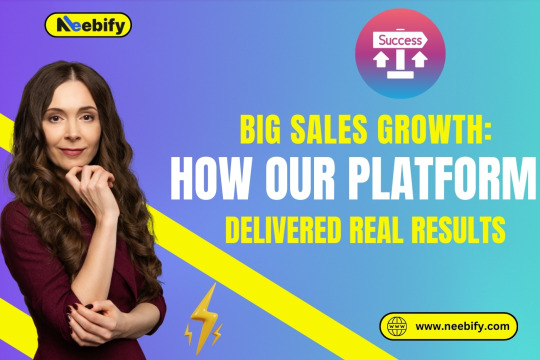
Neebify is the platform which uses automation coupled with CRM systems for delivering real and measurable results for businesses. It automates getting connection requests, messaging, and follow-ups in line with guidelines on LinkedIn. The other core features include automated outreach, CRM integration, targeting your audience, customized campaigns, and analytics or reporting.
There are high expectations to view LinkedIn automation as a step that can play an important role in today's sales strategy, including sending in connection requests, messages, and follow-ups at mass levels by streamlining the efficiency. In this case, it will make sure to produce even more qualified leads, consistency in engagement, scalability, and even super management of the data.
Yes, a mid-sized B2B software company had a case study that showed how Neebify transformed the entire LinkedIn outreach approach to remarkable sales growth. Neebify explained to the company that they could help it overcome the challenge of a small number of connections, which could not help scale, and a limited reach because their sales force had to send connection requests and follow-up messages manually. Neebify offered them a solution that would allow them to reach more prospects, keep leads engaged consistently, and connect their LinkedIn efforts with their CRM for better management of leads.
In conclusion, Neebify is the future of sales growth automation, as through good automation and proper CRM systems, its use can bring optimum results for businesses in the future.
A B2B software company used Neebify for automated LinkedIn outreach and its integration with their CRM. They used Neebify to send customized connection requests to industry decision-makers and influencers and then followed up automatically with a series of follow-up communications to nurture those connections and move people further down the sales funnel. They hooked up their CRM so sales were spending more time closing deals and less time wrangling data.
Neebify provided advanced filtering features that allowed the company to pinpoint leads of interest with precision based on title, industry, and company size. The company was allowed to create several campaigns on LinkedIn, targeting different aspects of the target audience.
Between three months, the company managed to realize an impressive 200% growth in sales opportunities, and conversion rates improved, leads were handled in a better way, less time spent at work not automated, and data-driven decisions made in a much more efficient way. Among the most outstanding ones was the plan targeting decision-makers in the tech industry where the acceptance rate of connection requests had reached as high as 150%.
By combining Neebify's LinkedIn automation tool with its integration into a CRM, it could potentially really get the sales of businesses sky-rocketing. This is due to the fact that every sales effort would scale while not dropping personalization and efficiency. One good example would be the case of the B2B software company where the right application of automation on a LinkedIn strategy could really reach new heights while bringing in significant, measurable results.
2 notes
·
View notes
Text
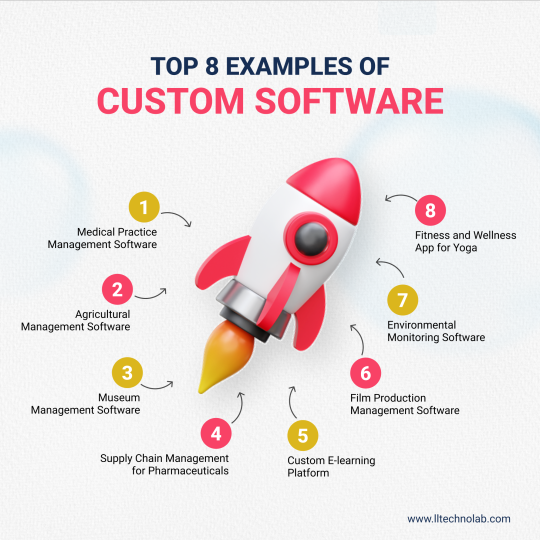
Discover the Top 8 Examples of Custom Software That Revolutionize Businesses. From tailored CRM systems to advanced inventory management solutions, see how custom software drives efficiency, security, and growth. Explore now! https://tinyurl.com/mrx3xmja
2 notes
·
View notes
Text
The Future of ERP Software in India: Trends to Watch in 2024
As India continues to solidify its position as a global economic powerhouse, the demand for sophisticated Enterprise Resource Planning (ERP) solutions has never been higher. ERP software companies in India are at the forefront of this transformation, driving innovation and efficiency across various industries. As we look ahead to 2024, several key trends are shaping the future of ERP software in India. This blog delves into these trends, offering insights into how ERP software providers in India are gearing up to meet the evolving needs of businesses.
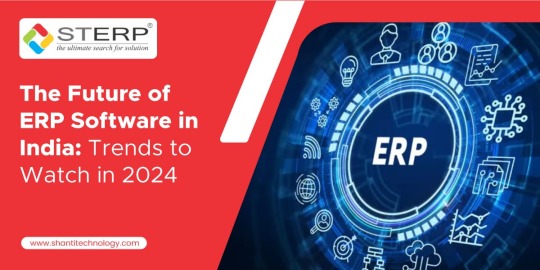
1. Increased Adoption of Cloud-Based ERP Solutions
One of the most significant trends in the ERP landscape is the shift towards cloud-based solutions. ERP software companies in India are increasingly offering cloud-based ERP systems to meet the growing demand for flexibility, scalability, and cost-efficiency. Cloud ERP solutions eliminate the need for extensive on-premises infrastructure, allowing businesses to reduce capital expenditure and streamline operations.
Cloud-based ERP systems also facilitate real-time data access and collaboration, enabling businesses to make informed decisions quickly. This trend is particularly beneficial for small and medium-sized enterprises (SMEs) that require affordable and scalable ERP solutions to compete effectively in the market.
2. Integration of Artificial Intelligence and Machine Learning
Artificial Intelligence (AI) and Machine Learning (ML) are revolutionizing the ERP landscape. ERP software providers in India are integrating AI and ML technologies to enhance the capabilities of their solutions. These technologies enable predictive analytics, automate routine tasks, and provide intelligent insights, helping businesses to optimize their operations.
For instance, AI-powered ERP systems can forecast demand, manage inventory levels, and predict maintenance needs, significantly improving efficiency and reducing costs. As AI and ML technologies continue to evolve, their integration into ERP systems will become more sophisticated, offering even greater value to businesses.
3. Focus on Industry-Specific ERP Solutions
ERP software companies in India are increasingly developing industry-specific ERP solutions to cater to the unique needs of different sectors. Whether it is manufacturing, retail, healthcare, or finance, each industry has distinct requirements that generic ERP systems might not fully address. Industry-specific ERP solutions offer tailored functionalities and workflows, ensuring better alignment with business processes.
For example, a manufacturing ERP system might include features for production planning, quality control, and supply chain management, while a retail ERP system could focus on inventory management, point of sale (POS) integration, and customer relationship management (CRM). This trend towards specialization ensures that businesses can leverage ERP systems that truly support their operational needs.
4. Enhanced Mobile Accessibility
With the proliferation of smartphones and mobile devices, the need for mobile-friendly ERP solutions is growing. ERP software providers in India are developing mobile applications that allow users to access critical business information on the go. Mobile ERP solutions enable employees to perform tasks such as inventory checks, sales order processing, and expense reporting from their smartphones or tablets.
This trend not only improves accessibility but also enhances productivity by enabling employees to work remotely and make decisions in real-time. As mobile technology continues to advance, the functionality and user experience of mobile ERP applications will improve, making them an indispensable tool for modern businesses.
5. Increased Emphasis on Data Security and Compliance
As businesses become more reliant on digital technologies, data security and compliance have become paramount. ERP software providers in India are prioritizing data protection by incorporating advanced security features into their solutions. This includes encryption, multi-factor authentication, and regular security audits to safeguard sensitive business information.
Moreover, with the implementation of regulations such as the General Data Protection Regulation (GDPR) and India’s Personal Data Protection Bill, compliance is a critical concern for businesses. ERP software providers are ensuring that their systems comply with these regulations, helping businesses avoid legal penalties and build trust with their customers.
6. Rise of Hybrid ERP Solutions
While cloud-based ERP systems offer numerous advantages, some businesses prefer on-premises solutions due to specific regulatory or operational requirements. To cater to these diverse needs, ERP software companies in India are offering hybrid ERP solutions that combine the benefits of both cloud and on-premises systems.
Hybrid ERP solutions provide the flexibility of cloud-based systems while allowing businesses to maintain critical applications on-premises. This approach offers a balanced solution, enabling businesses to optimize their IT infrastructure based on their unique needs and preferences.
7. Adoption of Advanced Analytics and Business Intelligence
Data is the new currency in today’s business environment, and the ability to harness and analyze data is a key competitive advantage. ERP software providers in India are integrating advanced analytics and business intelligence (BI) tools into their systems. These tools enable businesses to gain deep insights into their operations, identify trends, and make data-driven decisions.
Advanced analytics and BI tools can analyze large volumes of data from various sources, providing comprehensive reports and dashboards. This helps businesses to monitor performance, identify inefficiencies, and uncover new opportunities for growth.
8. Greater Focus on User Experience and Interface Design
The user experience (UX) and interface design of ERP systems are critical to their adoption and effectiveness. ERP software companies in India are placing a greater emphasis on developing intuitive and user-friendly interfaces. This trend is driven by the need to ensure that ERP systems are accessible and easy to use for all employees, regardless of their technical expertise.
Modern ERP systems feature clean, responsive interfaces with customizable dashboards and navigation options. This focus on UX design helps to improve user satisfaction, reduce training time, and increase overall productivity.
9. Integration with the Internet of Things (IoT)
The Internet of Things (IoT) is transforming the way businesses operate by enabling real-time monitoring and data collection from connected devices. ERP software providers in India are integrating IoT capabilities into their systems to enhance operational efficiency and decision-making.
IoT-enabled ERP systems can monitor equipment performance, track inventory levels, and optimize supply chain operations. For example, sensors placed on manufacturing equipment can detect anomalies and trigger maintenance requests before a breakdown occurs. This integration of IoT with ERP systems allows businesses to leverage real-time data for proactive management and improved efficiency.
10. Sustainable and Green ERP Solutions
Sustainability is becoming a key consideration for businesses across industries. ERP software companies in India are developing solutions that support sustainable practices and environmental responsibility. Green ERP solutions help businesses to monitor and reduce their environmental impact by tracking energy consumption, waste management, and resource utilization.
By integrating sustainability metrics into their ERP systems, businesses can set and achieve environmental goals, comply with regulations, and enhance their corporate social responsibility (CSR) initiatives. This trend towards sustainable ERP solutions reflects the growing importance of environmental stewardship in today’s business landscape.
Conclusion
The future of ERP software in India is marked by innovation, adaptability, and a deep understanding of the unique needs of businesses. ERP software providers in India are leading the charge, offering solutions that are not only technologically advanced but also aligned with the evolving demands of the market. As we move into 2024, the trends highlighted in this blog will play a crucial role in shaping the ERP landscape, driving efficiency, and fostering growth across industries.
ERP software providers in India are well-positioned to support businesses in their digital transformation journeys, providing the tools and insights needed to thrive in a competitive environment. By staying ahead of these trends, businesses can leverage ERP solutions to achieve operational excellence and sustainable growth.
#ERP software Companies in India#ERP software providers in India#ERP software company in India#ERP software in India#ERP solution provider#ERP software#ERP system#cloud ERP#ERP solutions
4 notes
·
View notes
Text
Unlocking Exponential Growth: Mastering Compounding Advantage in SMBs with Proven Strategies
In the dynamic world of small and medium-sized businesses (SMBs), compounding advantage is a key driver for sustainable growth. This blog will explore how SMBs can leverage this powerful strategy for scalable success, illuminated by real-life examples.
Understanding Compounding Advantage in Business
Compounding advantage (Econ term) is akin to a snowball effect in business, where initial gains are built upon, leading to exponentially greater growth over time. For SMBs, this means transforming initial successes into a positive, self-reinforcing cycle of progress.
Key Areas for Compounding Growth in SMBs
1. Customer Loyalty: Prioritizing customer satisfaction is critical. A study by Bain & Company revealed that a 5% increase in customer retention can increase profits by 25% to 95%.
2. Brand Reputation: Consistent quality and service enhance brand reputation, organically growing the business.
3. Technology and Automation: Technology investments can lead to compounding efficiencies over time, which is crucial for scalable growth.
Real-Life Success Stories
1. Retail Example: Barnes & Noble saw success with their subscription-based loyalty program, offering exclusive discounts and free shipping. This created a significant customer retention effect.
2. E-commerce Example: Amazon Prime demonstrates the power of a well-crafted subscription-based loyalty program. Prime members spend significantly more annually than non-Prime customers, highlighting the program’s effectiveness in customer retention and spending.
3. Digital Engagement Example: TheCHIVE, a photo entertainment website, used gamification to enhance customer engagement. Their approach contributed significantly to their annual revenue and site visits.
4. Fashion E-commerce Example: Lively implemented a loyalty program that increased customer lifetime value and average spend, showcasing the benefits of engaging loyalty strategies.
5. Consulting Services Example: CRM software’s (Salesforce, HubSpot, Zoho, etc.) impact on SMBs is notable. Companies utilizing CRM have seen a reduction in sales cycles by 8-14%, emphasizing the importance of technology in customer relationship management.
A Step-by-Step Guide to Compounding Your Business Growth
Identify Growth Areas: Pinpoint aspects of your business ripe for compounding growth.
Measure and Track: Regularly monitor and track progress using metrics and analytics.
Maintain Consistency: Regular reviews and adjustments are key to maintaining compounding growth.
Overcoming Challenges
Challenges like budget constraints and resistance to change are common. Overcoming these requires a strategic focus on long-term benefits.
Path to Exponential Growth
Compounding advantage is a vital tool for SMBs. By focusing on customer satisfaction, technology, and brand reputation, businesses can set themselves on a trajectory of exponential growth.
3 notes
·
View notes
Text
The Crucial ERP System Examples: Transforming Business Operations

In today’s fiercely competitive business realm, the quest for operational efficiency and streamlined management is paramount. Enterprise Resource Planning (ERP) systems stand tall as technological marvels, revolutionizing the way businesses operate. These robust software solutions amalgamate various functions within a unified framework, enabling seamless coordination across departments and facilitating data-driven decision-making.
This exploration ventures into the realm of ERP systems, shedding light on a spectrum of exemplary solutions that have reshaped modern business operations. From stalwarts like SAP ERP and Oracle ERP Cloud to innovative players like Microsoft Dynamics 365 and Odoo, each system represents a unique amalgamation of features, functionalities, and industry applications.
This comprehensive journey traverses the functionalities, industry adaptability, and transformative potentials of these ERP systems. Understanding their intricacies is pivotal for businesses seeking to optimize processes, unlock efficiencies, and navigate the complexities of today’s business landscape. Join this insightful exploration to unravel the significance and impact of these ERP system examples in shaping the future of business operations.
ERP System Examples
1. SAP ERP: Revolutionizing Business Management
SAP ERP has solidified its position as a leader by providing an all-encompassing suite covering critical business functions. Beyond its core modules in finance, HR, and supply chain, SAP offers specialized applications for industry-specific needs. For instance, SAP S/4HANA, an intelligent ERP, integrates AI and analytics for real-time insights, empowering businesses to adapt swiftly to market changes.
The scalability of SAP ERP is noteworthy, catering to startups aiming for growth and global corporations managing complex operations. It provides modular solutions, enabling businesses to adopt specific functionalities based on their immediate needs.
2. Oracle ERP Cloud: Innovating Operations in the Cloud
Oracle ERP Cloud’s robust suite extends far beyond traditional ERP capabilities. It embraces emerging technologies like AI, machine learning, and blockchain to drive innovation. Its predictive analytics empower businesses to anticipate market trends, optimize supply chains, and mitigate risks effectively.
The cloud-based structure of Oracle ERP Cloud ensures not just accessibility but also scalability without compromising security. It enables seamless integration with other Oracle Cloud applications, fostering a unified ecosystem for comprehensive business management.
3. Microsoft Dynamics 365: Integrating CRM and ERP Capabilities
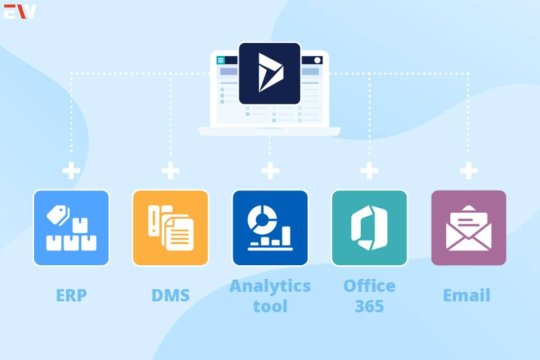
Microsoft Dynamics 365 is a fusion of CRM and ERP functionalities, providing a holistic platform for businesses. Unlike its core ERP modules, Dynamics 365 offers advanced tools for customer engagement, field service, and marketing automation. Its flexibility lies in its modularity, allowing businesses to tailor their systems by choosing specific applications that align with their objectives.
Moreover, its integration with Microsoft Office 365 and Power Platform strengthens collaboration and data analysis, facilitating informed decision-making across departments.
4. NetSuite: Empowering Diverse Industries
NetSuite’s cloud-based ERP system addresses the complex needs of various industries. Its suite encompasses solutions for financial management, e-commerce, and inventory control. Beyond the core ERP functionalities, NetSuite offers industry-specific modules, such as SuiteCommerce for retail businesses and SuiteSuccess for services, enhancing its appeal across diverse sectors.
The scalability and adaptability of NetSuite make it a preferred choice for businesses experiencing rapid growth or seeking to expand into new markets.
5. Infor ERP: Tailored Solutions for Specific Sectors
Infor’s industry-specific ERP solutions cater to the nuanced requirements of sectors like healthcare, manufacturing, and distribution. In addition to its standard ERP functionalities, Infor focuses on specialized applications such as Infor CloudSuite Healthcare for healthcare organizations and Infor LN for manufacturing, ensuring tailored solutions for sector-specific challenges.
Infor’s commitment to innovation and addressing sector-specific complexities underscores its relevance in the ERP landscape.
6. Epicor ERP: Amplifying Industry Operations
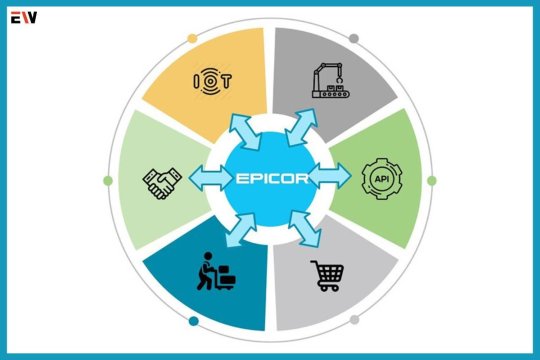
Epicor ERP excels in catering to industries such as manufacturing, distribution, retail, and services. Its core ERP functionalities are complemented by advanced analytics and business intelligence tools. Epicor’s Smart Inventory Planning and Optimization (IPO) tool, for instance, utilizes AI to enhance inventory management, improving efficiency and reducing costs.
Moreover, its agile architecture enables easy customization and integration with third-party applications, providing businesses with a highly adaptable solution.
7. Odoo: Flexibility and Customization
Odoo’s open-source ERP system offers an extensive suite of applications covering CRM, inventory management, project management, and more. What sets Odoo apart is its modular nature, allowing businesses to select and integrate specific applications as per their requirements. Odoo’s flexibility and affordability are especially beneficial for small to medium-sized enterprises seeking customizable solutions without exorbitant costs.
The Value of ERP Systems in Modern Business
ERP systems serve as catalysts for efficiency, productivity, and growth:
Streamlined Operations: Automating tasks streamlines processes, reducing manual errors and optimizing resource allocation.
Enhanced Data Management: Centralized databases ensure data consistency and accuracy, fostering informed decision-making.
Agile Decision-Making: Real-time data access empowers businesses to make agile decisions, staying ahead in dynamic markets.
Customer-Centric Approach: Integrated CRM functionalities enable businesses to deliver personalized services, boosting customer satisfaction and loyalty.
Making Informed Choices: Selecting the Right ERP System

The process of choosing an ERP system involves careful evaluation and alignment with a business’s unique needs. Understanding the scalability, integration capabilities, and industry-specific functionalities of each system is crucial for successful adoption.
Conclusion: Embracing ERP Systems for Sustainable Growth
The landscape of ERP systems continues to evolve, offering businesses versatile solutions to streamline operations, enhance efficiency, and foster sustainable growth. From SAP’s scalability to Oracle’s cloud-driven innovation and Odoo’s customization prowess, each system exemplifies the diverse capabilities shaping modern business management.
Selecting the right ERP system aligned with specific needs remains pivotal for organizations seeking resilience and competitiveness. As businesses strive for optimization and adaptability, embracing these transformative technologies ensures a strategic advantage in an ever-evolving market. It stands as a pillar of efficiency, empowering businesses to navigate complexities and drive success through informed decisions and streamlined operations.
Also Read: A Deep Dive into Corporate Wellness Programs for a Healthier, Happier Workplace
#ERPRevolution#BusinessTransformation#TechInnovation#DigitalTransformation#EnterpriseSolutions#InnovationInBusiness#TechLeadership
2 notes
·
View notes
Text
Why Salesforce Developers are Unexplained Forces of Business (2023)

According to the company’s own website, Salesforce is known to be the world’s number one customer relationship management (CRM) platform. It is a software whose sole purpose is to help businesses grow by helping them understand the specific needs of their customers by using certain cloud-based apps that are designed for sales, marketing, and service.
However, since no 2 companies are the same, their Salesforce requirements will be different as well. When this takes place, it is usually good to have a top Salesforce development company handy, a company that is well-versed will customise the software development and in providing tailor-made solutions.
If this is something that piques your interest or if you are someone who is already working in Salesforce but would like to up your skills, then this blog is for you.
So What Is A Salesforce Developer?
A Salesforce developer is any person who builds Salesforce applications across different Platform as a Service (PaaS) platforms. However, it is important to keep in mind that he/she does not need to work for Salesforce in any way, shape, or form.
What Do They Do?
A developer dealing in Salesforce has a deep understanding of how it works along with sufficient experience with the platform. A Salesforce developer or a Salesforce development company is hired by an organisation to customise Salesforce to the unique needs of the hiring party. However, it should also be said that the developer can even be someone who is an in-house programmer who has the necessary skills to work with Salesforce. Some of the tools that are used by these developers include Visualforce and Apex and frameworks like Lightning Component.
Roles and Responsibilities of These Developers
One thing that can be easily noticed is that the roles and responsibilities of a Salesforce developer are pretty similar to those of any other professional developer working in a top software development company in India.
However, just for the sake of completeness, here are the roles and responsibilities of these developers:
· Analyse user needs, and then plan, design, test, and develop software that meets their unique needs.
· Come up with effective project plans and develop Salesforce solutions. Also add more value to the 3 stages of project work: definition, development, and deployment.
· Provide useful suggestions regarding software upgrades for existing apps and systems.
· Stay ahead of the transforming technological landscape of Salesforce, and .Net/Java platforms and also adapt quickly.
· Develop every part of any application and then plan how those different parts can mesh together.
· Create programs for use over the internet and for in-house users over the company intranet.
· Properly handle inconsistencies in data and come up with processes that can counter any deficiencies.
· Collaborate with other programmers by creating flowcharts so as to instruct them on how to write additional software code.
· Ensure that a program runs efficiently by performing routine maintenance and testing.
· Keep a record of the inventory of the company’s systems and applications for future reference, especially when it comes to upgrades.
· Team up with other computer specialists to develop optimum software.
Other than the above-mentioned points, one must also remember that a Salesforce developer should always maintain a cordial rapport with the client to understand their operation and Salesforce implementation needs. For example, the developer must make it a point to figure out how the customer is trying to use the software and also identify the core functionality. This means paying extra attention to user needs that go well beyond the scope of the software, issues concerning security, and system performance.
Therefore, you should understand by now that a Salesforce developer has a lot on his/her plate. Their work is extremely challenging, however extremely rewarding as we are going to see below.
What Is The Salary Of A Salesforce Developer?
The average salary of a Salesforce developer in India is somewhere around Rs.500,000 per annum including both profit-sharing and bonuses. It only goes without saying that the bigger the company the more money they will pay for your services. Digital technology solution companies usually pay around Rs.10, 00,000 per annum. Big names in the field like Deloitte and Cognizant pay well above Rs.6, 00,000 per year.
Salesforce developer salaries also vary according to the experience of the individual. An entry-level developer can expect his/her salary to be around Rs.3, 00,000 per annum. However, after gaining an experience of about 2-5 years the compensation can get close to Rs.5, 00,000 per annum. And if someone gains an experience of around 9 years the hefty paycheck can get close to Rs.10, 00,000 per annum.
It is also useful to remember that the salary of a Salesforce developer also varies according to the location of the individual and his/her job as well.
What Are The Benefits Of Hiring A Salesforce Development Team?
The benefits of hiring a dedicated Salesforce development team for your business are many. Let's look at some of these benefits as listed below:
1) Building a core business
One of the best ways of managing your in-house resources is by outsourcing your Salesforce development needs. Instead of having an in-house team, you can find experienced and thorough professionals in the field of Salesforce development taking care of your workload.
2) Skilled expertise
By having a quick look at the portfolio of the companies delivering dedicated Salesforce development services, you can get an idea of their expertise then and there. Therefore, by choosing a dedicated Salesforce team you can be certain of the fact that you have hired people with the right amount of expertise and skill set. They can not only understand your business processes but can also come up with the most apt cloud-based CRM solutions that are tailor-made for your business specifically.
3) 24/7 Availability
Needless a dedicated Salesforce development team will be ready to render their services round the clock. Nowadays, we live in a world where remote working has become the norm, and so have customisations and testing. Therefore, a team that will offer continuous support should always be sought out for. This way, even when the in-house team is sleeping, you will have a team of experts taking care of your CRM.
4) Cost-efficient
You can also save on costs by hiring a dedicated Salesforce development team in India. As a matter of fact, you can save up to 60% of your total costs. You can make use of this saved money to build your core business and pay more attention to business growth.
Nevertheless, here are a few wise words from Josh Kaufman on outsourcing, it goes like this - “For everything we don’t like to do, there’s someone out there who’s good at it, wants to do it, and will enjoy it.”
And that pretty much sums it all up. If you are really looking to get the best benefit from Salesforce, outsourcing is the best thing you can go for.
How to Become a Salesforce Developer?
After such an elaborate discussion on the roles and responsibilities of a Salesforce developer and the hefty compensation that comes with being one, you might ask “But how to actually become a Salesforce developer?” read on to find out about it!!
First, to begin with, most software developers including Salesforce developers have a bachelor’s degree in computer science, and software engineering along with excellent knowledge of computer programming. It is also useful to have knowledge and skills in the industry where these Salesforce skills can be put to the best of use. Moreover, you also need to have an understanding of Model-View-Controller design patterns, Object-Oriented Programming Principles, and Java, or .Net Programming.
Having an internship experience in a software business right after graduating from college also goes a long way. Arrangements like these can provide essential connections, skills, and much-needed experience. If you find it difficult to get a job as a developer, it is recommended to start as a programmer and then slowly work your way up to becoming a Salesforce developer.
In case, you want to become a Salesforce developer after a long time from graduating college, make sure to take an online course focussing on Salesforce development as it can teach you essential skills that are needed to get a job in a Salesforce development company. Certifications like these are crucial as they confirm to employers that you are armed with the skill set needed to do the job they want you to do.
What Are The Skills Required To Become A Successful Salesforce Developer?
In order to become a Salesforce developer there are certain specific skills that one needs to have and they are as follows:
· Analytical Skills: Having sufficient analytical skills assists in analysing the client’s needs and also in developing the requisite software.
· Communication Skills: These come in handy when dealing with customers as it might include explaining to them how an app works. It is also helpful in giving your juniors clear instructions on what needs to be done.
· Computer Skills: It goes without saying that excellent computer skills are a must-have for a Salesforce developer.
· Interpersonal Skills: a good Salesforce developer has to be someone who is doing teamwork at one point or another.
· Problem-solving Skills: This skill is probably the bread and butter of every developer. Being a developer you are in charge of overseeing every stage of the software development, and you can be assured of the fact that there are going to be problems at one stage or another.
In addition, it is also helpful for developers to be detail-oriented and be able to think out of the box. The former means developers need to be creative and in the latter case, a great developer must be able to deal with all the small details.
#SalesforceDeveloper#TechCareers#CRMDevelopment#BusinessSolutions#ITJobs#HiringSalesforce#CodingSkills#DigitalTransformation
2 notes
·
View notes
Text
Growth Hacking: Fuel To Your Retention Efforts
In today's fast-paced and highly competitive business landscape, customer retention has become a critical aspect of sustaining success. While acquiring new customers is vital for growth, retaining existing customers is equally important for long-term profitability and brand loyalty. This is where growth hacking comes into play as a powerful strategy to supercharge your retention efforts. In this article, we will explore how growth hacking can be utilized to enhance customer retention and foster sustainable business growth.
Understanding Growth Hacking
Growth hacking is a term coined to describe a data-driven and innovative approach to achieving rapid and sustainable business growth. It emerged as a concept in the tech startup world, where resources are often limited, and creative strategies are essential for success. Growth hackers focus on finding unconventional and cost-effective solutions to expand their user base and increase customer retention rates.
The Relationship Between Growth Hacking and Customer Retention
Traditionally, growth hacking has been primarily associated with customer acquisition. However, its principles and techniques can be seamlessly integrated into customer retention strategies. By understanding the customer lifecycle and their pain points, growth hackers can devise creative ways to keep customers engaged and loyal.
Key Strategies to Fuel Your Retention Efforts
Personalization at Scale: Growth hacking involves analyzing customer data to personalize experiences. Tailored recommendations, personalized emails, and custom offerings can make customers feel valued and understood. Utilize customer relationship management (CRM) tools to segment your audience and deliver relevant content.
Leveraging Behavioral Triggers: Growth hackers understand the significance of emotional triggers and behavioral psychology. By identifying key behavioral triggers that prompt customers to engage, you can optimize your retention strategies. For example, setting up personalized onboarding sequences can significantly impact user retention for software applications.
Gamification and Rewards: Gamification techniques, such as loyalty programs and reward systems, can boost customer engagement and retention. Implementing points, badges, and exclusive perks for loyal customers creates a sense of achievement and motivates them to stay connected to your brand.
Continuous Feedback Loop: Engage customers in a continuous feedback loop, seeking their opinions and suggestions for improvement. Not only does this foster a customer-centric approach, but it also helps identify potential issues before they escalate, leading to higher retention rates.
Viral Referral Programs: Encourage your existing customers to refer their friends and family through incentivized referral programs. This not only increases your customer base but also strengthens the sense of community around your brand.
A/B Testing and Iterative Improvements: Growth hacking relies on experimentation and iterative improvements. Implement A/B testing for various retention strategies to identify the most effective ones. Continuous optimization will ensure your efforts remain relevant and impactful.
Data-Driven Insights: Analyze customer data to gain insights into their preferences, pain points, and behaviors. Utilize this data to make informed decisions on how to retain your customers better.
Conclusion
In today's dynamic business environment, growth hacking has evolved from merely being a customer acquisition strategy to a powerful tool for enhancing customer retention efforts. By adopting a data-driven and customer-centric approach, businesses can leverage growth hacking principles to create personalized experiences, foster engagement, and build long-term relationships with their customers. Integrating growth hacking strategies with retention efforts can lead to sustainable growth, increased customer loyalty, and a competitive advantage in the market. Embrace growth hacking, and fuel your retention efforts to drive your business towards long-term success.
2 notes
·
View notes
Text
How Restaurant Management Software Streamlines Operations and Boosts Efficiency
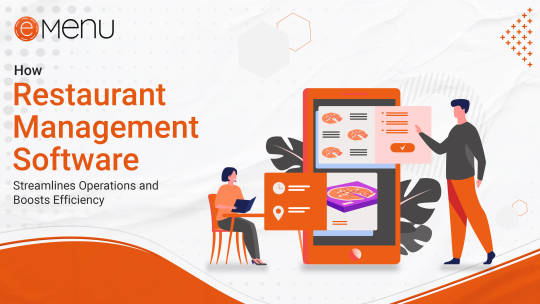
The restaurant industry is highly competitive, and efficient operations play a crucial role in the success of any establishment. In today's digital age, restaurant management software has emerged as a powerful tool to streamline operations and boost efficiency. This blog post explores the various ways in which restaurant management software revolutionizes the way restaurants operate, enabling them to deliver exceptional customer experiences while optimizing their backend processes.
The Role of Restaurant Management Software:
Online eMenu Restaurant management software is a comprehensive solution designed to handle the diverse aspects of running a restaurant. It encompasses a wide range of features and functionalities that simplify day-to-day operations, enhance productivity, and improve overall efficiency. From Restaurant tasks to Restaurant operations, the software offers a centralized platform to manage and streamline various processes.
Streamlining Restaurant Operations:
In the bustling environment of a restaurant, managing Restaurant operations efficiently is essential. Online eMenu Restaurant management software offers tools for reservation and table management software, allowing customers to book tables online and providing staff with real-time updates on reservations. This helps optimize table turnover and maximize seating capacity, leading to better customer service and increased revenue. Additionally, the software integrates with the point-of-sale (POS) system, enabling seamless order taking and processing.
Enhancing Restaurant Efficiency:
Efficiency in the Restaurant operations is equally important for smooth restaurant functioning. With restaurant management software, staff scheduling and labor management become hassle-free. The software automates scheduling, taking into account factors such as staff availability and workload, resulting in optimized staff allocation and improved productivity. It also tracks labor costs and performance metrics, providing valuable insights for effective decision-making.
Supplier and procurement management is another critical aspect that software addresses. By streamlining the ordering process and managing suppliers, restaurants can ensure timely and accurate deliveries. The software facilitates inventory forecasting, minimizing wastage and optimizing stock levels. Real-time reporting and analytics capabilities empower restaurant owners and managers to monitor sales, expenses, and performance, enabling data-driven decision-making.
Customer Relationship Management (CRM):
Building strong customer relationships is vital for the success of any restaurant. Restaurant management software Customer Relationship Management (CRM) helps in creating and maintaining customer profiles, capturing preferences, and analyzing data to deliver personalized experiences. Additionally, the software facilitates the implementation of loyalty programs and targeted marketing campaigns, allowing restaurants to engage with customers effectively and increase customer retention.
Ensuring Data Security and Accessibility:
Data security is a paramount concern in today's digital landscape. Restaurant management software offers robust security measures to protect sensitive customer information and business data. Cloud-based solutions provide data backup and ensure accessibility from anywhere, anytime, allowing owners and managers to monitor and manage their restaurant's operations remotely. User access control features further enhance data privacy and confidentiality.
Case Studies: Success Stories of Restaurant Management Software Implementation
Real-life examples of restaurants that have implemented restaurant management software can provide valuable insights into its effectiveness. Case studies highlighting specific improvements and outcomes achieved through the software demonstrate how it has helped restaurants streamline their operations, enhance efficiency, and deliver exceptional dining experiences.
Challenges and Considerations:
While restaurant management software offers numerous benefits, it's essential to consider potential challenges and factors when selecting the right software. Factors such as cost, scalability, user-friendliness, and integration capabilities with existing systems should be evaluated before making a decision. Addressing these considerations ensures a successful implementation and maximizes the software's potential.
Conclusion:
Restaurant Management software has become a game-changer in the industry, revolutionizing the way restaurants operate. By streamlining operations, enhancing efficiency, and optimizing processes, this software empowers restaurants to deliver exceptional customer experiences while driving profitability. As technology continues to shape the future of the restaurant industry, embracing restaurant management software becomes essential for those seeking.
#restaurant management software#contactless menu system#qr code#restaurant management system#restaurant pos system#contactless menu#contactless qr code menu#contactless ordering app#point-of-sale (POS) system#point-of-sale system#pos billing software#restaurant pos software#pos system#pos software#restaurant software#restaurant sales#restaurant#qrcodemenu#qr code menu#cloud based pos billing system#cloud based pos billing software#crm software#crmintegration#restaurant crm#restaurant crm software#crm development#online food ordering software#online food ordering system#food ordering system online#Restaurant Table Booking
4 notes
·
View notes
Text
Salesforce Implementation Partners: Missing Link in the Picture?
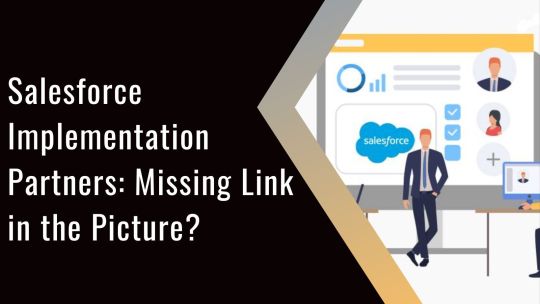
Salesforce is a powerful platform with amazing features and endless capabilities. Businesses, regardless of the industry verticals, look forward to implementing Salesforce to strengthen their relationship with customers. Though it might sound simple and easy, starting an implementation without diligent preparation and planning often results in poor outcomes, which can require time-consuming and costly rework—this is where Salesforce implementation partners come to your rescue.
This blog answers some of the most common questions that people often have about working with a Salesforce implementation partner. In addition, it also tells you how to make the most of this strategic collaboration.
In response to changes in customer behaviors, businesses of varying sizes and scopes are accelerating their digital transformation initiatives. A majority of them are interested in employing integrated, access-from-anywhere kind of solutions such as a Customer Relationship Management (CRM) software/platform— just like the ones offered by Salesforce.
Here is what the statistics have to say about one of the fastest-growing categories of enterprise software: the global spending on Salesforce is projected to be around 675 billion U.S. dollars in the current year. In the previous year, Salesforce took approximately 24% market share of the global CRM applications market.

Going forward, exploring a Salesforce CRM solution is one aspect; knowing what applications, products, as well as configurations best suit your business-specific needs is totally another matter. Perhaps, this is why a majority of Salesforce customers resort to accredited experts to ease their entry into the world of Salesforce. These dedicated experts are your implementation partners. There is a wide network of Salesforce implementation partners that assist businesses to achieve their CRM goals quickly and effectively.
What is an Implementation Partner?
To put it in simple words, an implementation partner is a company that has been approved by Salesforce after reviewing it to implement Salesforce CRM solutions on its behalf where each implementation partner specializes in some specific areas, applications, or industries. This implies that there is a partner that caters to every business need, challenge, product, industry vertical, region, etc., and assists us along the entire Salesforce journey.
Why do Businesses Need an Implementation Partner?
Salesforce CRM solutions are known to cover the entire spectrum of business operations, which include marketing, sales, service, as well as sustainability. Each of its products can be bolstered via platform-to-platform integrations and add-on applications.
In other words, the entire Salesforce ecosystem offers endless capabilities—where the main challenge is to select the right product with the integrations and configurations that best fit your business-specific needs. Consider the case in point, a big organization might already be working with multiple technological solutions. They want to figure out how a Salesforce product, for example, Marketing Cloud, can be integrated with their existing workflows without causing friction, and are looking for assistance for the same.
Take another case in point, a smaller company might be scaling upwards quickly. They also know that continuing to work with spreadsheets would not support their growth. Amidst this, they realize that they must automate their processes—or it is time to develop more streamlined and personalized customer experiences.
Implementing a CRM solution for the first time can be daunting for a majority of companies. It is a challenging task for internal teams or employees with no experience in Salesforce to take into consideration all the variables as well as implement a new and highly configurable CRM solution. Besides, hiring a full-time employee to look after the CRM implementation process can also be a costly avenue.
These were some of the situation-specific reasons that a significant chunk of Salesforce customers resort to partner applications and experts.
When is the Right Time to Engage with Implementation Companies?
As early as possible would be apt if it were to be answered in a nutshell.
You need to do your due diligence, just like you do with any significant investment. First of all, figure out what needs have to be met, gaps that have to be closed, or issues that need to be addressed. Talking of the Salesforce implementation case, you must formulate a vision of what you want to achieve that is the ‘what.’ After this, determine the ‘how,’ which is often the most complicated part for any business.
It is time to bring in a partner as soon as you figure out your goals. The right implementation partner will not just facilitate the ‘how,’ but they’ll also help you crystallize the ‘what’. They will assist you to clarify your success metrics, understanding what is realistic, as well as advise on appropriate products. Accordingly, the experts will lay out a logistically sound timeline for your implementation journey to finish it off.
It is important to note that bringing in a partner late in the game usually results in missed opportunities—in terms of understanding and scope. As the relationship between a partner and a customer is close and collaborative, the only secured way to ensure seamless implementation is when the journey begins together.
How to Figure Out the Right Implementation Partner?
Some of the implementation partners have generalized Salesforce capabilities. More often than not, these companies specialize in particular functions or areas of the CRM solution. While some might specialize in customer data platforms (CDP) or Marketing Cloud, others might specialize in harnessing the combined powers of Einstein and Sales Cloud.
Another factor is value alignment, which has come to the forefront in recent years. People want to work with companies that share their values. What we mean here is that people prefer to work with an organization that prioritizes sustainability or champions diversity and equality.
Shopping around is a good practice irrespective of whether or not these things are top-of-mind for you. Interact with different Salesforce partners, get a feel of who they are, know the way they work, and so on. As this is an important relationship, we would recommend you not settle for anything less than the right fit for your business.
Salesforce AppExchange is the best as well as a most comprehensive resource for both partners and products. There are plenty of experts and numerous applications at your fingertips where one can also browse specializations, certifications, and customer reviews.
In short, certifications, as well as credentials come into play as does the specific expertise of that implementation company.
What Challenges Might a Business Encounter During Implementation?
It has already been stressed enough that bringing in a partner as early as possible decreases the chances of challenges that might be emerging down the line.
What is also important apart from this is to be clear on what you want to solve, plus how you measure success over time. Most instances of dissatisfaction or confusion emerge from a lack of understanding on the part of the partner or the customer. Fault assumptions can be made and misunderstandings on capabilities and timelines can arise if both the parties, partner and customer are not on the same page. This makes goals, objectives, and success benchmarks harder to be reached.
As a customer, you need to be as transparent as you want your Salesforce implementation partner to be. Genuine advice is that you should never be afraid to ask questions more than once and it is better to clear all the doubts that you have got—the implementation process is highly technical in nature and seeking clarification in this is quite natural.
Just as stakeholders place the customer at the center of their business, Salesforce implementation partners place them at the center of theirs. Also, they measure their success by aligning the outcomes to your business-specific needs; in other words, by delivering exactly what you need. For dedicated Salesforce implementation companies customer success equals partner success.
Last but not the least, every successful relationship in life thrives on honest, open communication from the outset; and the Salesforce implementation partnership is no exception to this rule.
Final Thoughts
To achieve exceptional results and maximize license usage, it is important to ensure that your Salesforce solution is fully tuned to business-specific needs and well-adopted by your organization. To maximize the success of Salesforce implementation, you need to engage with a Salesforce implementation partner.
You might be missing out on the potential opportunities in terms of scope and understanding, due to insufficient resources or skill gaps. Besides, the relationship between an implementation partner and a customer is collaborative and close. So, the only way to ensure a successful implementation is when the journey begins together.
The next step is to meet and network with different partners to get a feel of who they are, what is their way of working, and so on—this is an important relationship, so you must not settle for anything less than the best fit for your business. Now that you know what is right for you, it is time to make the move.
#salesforce implementation partners in india#salesforce implementation partners#salesforce implementation companies in india#salesforce implementation companies#salesforce implementation services#salesforce implementation consultant#salesforce implementation company#salesforce cloud implementation#salesforce cpq implementation partners
1 note
·
View note
Text
What is Lead Nurturing Examples Strategies & Tips
In marketing, just such as in relationships, trust is not built overnight. You do not propose on the first date expecting a resounding yes. Instead, you take time to understand the other person, communicate consistently & show up with genuine value. That is exactly what lead nurturing is all about—building meaningful connections with potential customers over time until they are ready to buy.
Whether you are a student exploring the basics of marketing automation, a sales leader aiming to increase conversions or a business decision maker planning long term growth understanding lead nurturing is key to sustainable success. Let us break it down clearly without fluff.
What is Lead Nurturing?
Lead nurturing is the process of developing & reinforcing relationships with potential customers at every stage of the sales funnel. Rather than pushing a product aggressively, the focus is on providing relevant content education & communication that matches where the lead is in their buyer journey.
In short, lead nurturing helps guide prospects from interest to decision at their pace not yours.
Why Lead Nurturing Matters?
Only a small percentage of leads are ready to make a purchase decision immediately after expressing interest. In fact many studies show that more than 90 percent of leads do not convert right away.
Without nurturing, they go cold or worse they go to competitors who provide more value during the decision making process.
Effective lead nurturing keeps your brand top of mind, builds trust & increases the chance that a lead will choose you when the time is right.
A Quick Story from the Real World
Imagine a company offering data analytics software. They attend a tech event & collect hundreds of email addresses from curious attendees. Most of these contacts are not ready to invest immediately; they just wanted to learn more.
Instead of blasting them with a product pitch, the company sends useful guides on analytics trends, invites them to webinars & shares success stories from clients in similar roles. Some participants also come from a technical background & often enroll in a Salesforce Developer Course to enhance their CRM understanding before moving further into platform decisions. Over weeks & months some recipients begin to engage more, download case studies & book a demo.
That is lead nurturing in action. It transforms cold contacts into educated warm prospects without forcing the sale.
Types of Lead Nurturing Content
Nurturing is not a one size fits all process. Different stages in the funnel call for different content formats. Here are some examples.
Top of Funnel Awareness Blog posts, industry news, checklists educational videos
Middle of Funnel Consideration Case studies, product comparisons, white papers & webinars
Bottom of Funnel Decision Demo's pricing guides personalized emails customer testimonials
By matching content to where the lead is mentally & emotionally in their buying process, you keep them engaged without overwhelming them.
Proven Lead Nurturing Strategies
Here are five strong strategies used by companies across industries
1 Email Drip Campaigns
Automated emails delivered on a schedule are a classic way to stay in touch. These should feel helpful & personal, not robotic. Each email should have a clear purpose, whether that is educating answering common questions or nudging the lead to take the next step.
2 Segmentation
Not all leads are alike. Segmenting your leads by industry, behavior, role or stage helps you tailor messages to be more relevant. For example, a CMO at a SaaS company & an operations manager at a manufacturing firm have different needs, so treat them that way.
3 Behavior Based Triggers
Modern marketing platforms let you track user behavior like clicks, downloads or time spent on pages. Use these signals to trigger follow ups. If someone spends five minutes on your pricing page that is a sign they are interested, so reach out while you are still top of mind.
4 Multi Channel Outreach
Do not limit nurturing to email. Use a mix of channels, including LinkedIn, social media retargeting ads & even phone calls where appropriate. A gentle presence across touchpoints makes your brand feel more reliable & approachable.
5 Timely Educational Content
Offer content that addresses specific problems or questions your leads are likely facing. Think of yourself as a guide rather than a seller. Providing the right insight at the right time earns trust naturally.
Tips for Successful Lead Nurturing
Stay consistent but do not overwhelm. Find a balance in frequency so you are remembered but not annoying.
Use personalization beyond the name. Tailor based on role, industry, or pain point.
Align sales & marketing teams. Both teams should agree on what makes a lead sales ready.
Measure & improve Track open rates, click-throughs & conversions to see what is working.
Be patient & persistent. Nurturing takes time but pays off in higher quality conversions.
Final Thoughts
Lead nurturing is more than a strategy it is a mindset. It is about seeing potential customers not as transactions but as people with real needs, questions & timelines. When you nurture leads thoughtfully, you are not just boosting conversions; you are building long term loyalty.
In today’s digital first world where attention is scarce but trust is priceless lead nurturing is the bridge that turns interest into action.
If you want to master these techniques further exploring a Generative AI Online Course can also help enhance your marketing automation approach making nurturing even more dynamic & effective.
0 notes